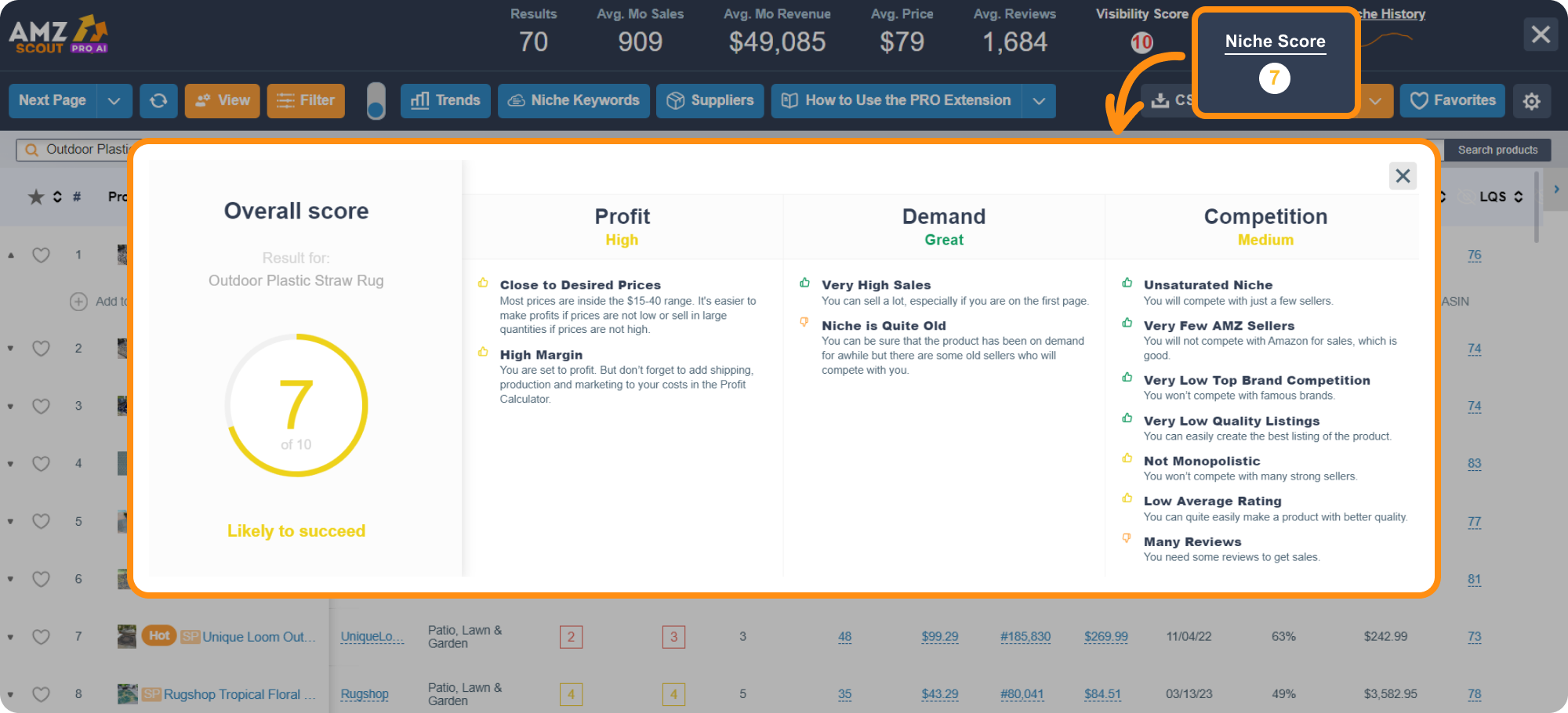
Amazon Wishlist: What Sellers Need to Know
It’s hard to imagine Amazon without its convenient Wish List feature, which is a perfect way to save products you like for later. But this feature isn’t just useful for shoppers. Wish Lists also offer sellers a unique glimpse into buying intent before customers reach the “Add to Cart” step of the process.
In this article, we’ll explain how Amazon Wish Lists work in 2025 so you can use them to your advantage and grow your business.
Table of contents
How Amazon Wish Lists Work
Amazon Wish Lists are personal collections where users save items by clicking “Add to List” on a product page or tapping the heart icon in the app. You can customize each item by adding notes, setting a quantity, and assigning a priority level. Wish lists provide a useful way to help shoppers organize items into categories especially when they’re looking for gifts. And with Alexa integration, you can now manage your Wish List hands-free by asking her to read or add items aloud.
Note: Wish Lists can be set to “Private” or “Public”, so you can have a list just for yourself, or share it with someone by sending them a link or email invite.
How to Find Your Amazon Wish List
To view or create a list, go to Account & Lists on the website, or tap the second icon down in the app to open Your Lists. You can edit your list anytime, including updating the name, privacy settings, or shipping address, and even move items between lists.
While Wish Lists are designed for shoppers, they also offer great insights for sellers. In the next section, we’ll explain how to use this information to improve the performance of your business.
Why Amazon Wish Lists Matter for Sellers
Although Amazon doesn’t show sellers which buyers have added their products to a Wish List, some Wish Lists are public and can be viewed by anyone. Here's how to find them:
1. Go to “Account & Lists” and select “Find a List or Registry.”
2. Enter a name in the search field. These public lists only show limited information — typically the person’s name and state — so feel free to try any name that comes to mind.
You can narrow down your search by adding filters such as:
State
Event type (e.g. birthday, wedding, or pet-related events)
3. Browse public Wish Lists to view items that people want or have already purchased.
To spot broader trends, you’ll need to explore multiple lists and look for recurring product types or categories. For a quicker overview, visit Amazon’s “Most Wished For” section. This page is updated daily and shows the most frequently added products across categories.
The Wish List is a valuable resource for sellers in several ways:
Find new product ideas: Browsing public Wish Lists gives you a real-world look at what people want, even before they buy.
Gauge demand in a niche: Seeing specific types of items appear repeatedly in different lists can help sellers identify trending niches or high-interest categories.
Plan inventory more effectively: If shoppers are saving your product but not purchasing it right away, this may be because it’s a seasonal item or something they’re waiting to buy later. This insight can help you plan your stock levels accordingly.
The Difference Between Adding to Cart and Buying
A product may appear among the top items on Wish Lists, yet still have modest sales. For example, a candle ranked #55 in Amazon’s Most Wished For list in the Tools & Home Improvement category had an estimated 200 sales last month, while another product ranked #100 generated over 3,000 sales.
This shows that even though more people added the candle to their lists or carts, many didn’t complete the purchase. In short, adding to a cart or Wish List doesn't always translate to a sale.
If a product is getting attention but not converting into sales, something may be holding customers back. If you notice this pattern with your own product, this is a good opportunity to dig deeper and identify the reason behind it.
Analyzing Products From Wish Lists
To understand why a product might be added to a Wish List but not making it to the shopping cart, you can use AMZScout PRO AI. This tool combines the latest Amazon data with advanced AI technology to help you identify what’s holding buyers back. To use it, just follow these steps:
1. Install the PRO AI Extension. Enter your email address to start a free trial.
2. Search for a product. Start by finding the product you want to analyze on Amazon (for example, a crib with a mattress included).
3. Get AI insights instantly. You don’t even need to open the product page. Just click “Analyze with AI” on the left side of the product image to get instant insights, including:
AI Product Insights: See the product’s strengths and weaknesses at a glance.
Example: A high price point of $249.99 may limit affordability for some buyers, signaling that pricing could be a barrier to sales.
AI Product Improvement Tip: If you're a brand owner, use these insights to figure out what can be improved and make your product stand out.
4. Check the niche performance. Sometimes, the issue isn’t with the product itself, but with the overall niche. To evaluate the market, click the AMZScout icon in the upper corner of your browser. In the top-right of the AMZScout window, you can view:
Niche History: See how similar products in the category have performed over time.
Niche Score: A score above 7 indicates a healthy balance of demand, profit potential, and manageable competition within the niche.
Note: At the bottom of the Niche Score section, you'll also see an AI-driven niche analysis, including key data on trends, competitors, pricing strategies, and more.
This helps you understand whether you're dealing with a product issue or a niche-wide challenge.
It’s also helpful to check reviews of your product (and similar ones) to understand what customers like or dislike. Just open the AI Product Analyzer to get a clear breakdown of common areas of praise and complaints, all in one place. This enables you to get a better understanding of why a product might be added to a Wish List but not purchased. These insights can help you make improvements that turn interest into actual sales.
How Buyers Can Use Amazon Wish Lists
Amazon Wish List is a simple yet versatile tool that helps customers optimize their online shopping journey. Here are the main ways buyers typically use this feature:
Save your favorite products for later: Wish Lists help keep track of items you like but aren’t ready to purchase yet. Plus, you’ll get reminders so you don’t forget them later.
Organize your shopping by needs or interests: Create separate lists for books, home essentials, tech gear, or anything else to keep things sorted and easy to find.
Share ideas with others: You can also share your list with anyone who asks, “What do you want?”, which makes choosing gifts easier. This is especially helpful for families who plan purchases together, making discussions more efficient and convenient for everyone involved.
Plan future purchases or stick to a budget: Wish Lists make it easy to plan ahead, since you can add stuff that you need now and space out purchases over time, helping you stay within your budget.
Watch for deals and price drops: Amazon notifies you when prices change, so you can grab what you want at the best time.
Compare similar products before buying: Add a few options to your list to weigh various features, reviews, and prices side by side.
Tip: Amazon Wish Lists are synced across all of your devices, making it easy to access and update your lists anytime, anywhere.
A Wish List is a reflection of a shopper’s interests, needs, and future plans, offering a snapshot of what they value or intend to buy. By carefully analyzing this information and comparing it to actual sales results, sellers can adjust their product offerings to align more accurately with customer demand.
FAQs
How do I make an Amazon Wish List?
To make an Amazon Wish List, go to Account & Lists and click Your Lists. In the top-right corner, select Create a List and give it a name. To change settings (like visibility or Alexa access), click the three-dots to access the menu, choose Manage List, then hit Save Changes. There’s no limit to how many lists you can create, and you can move items between them anytime.
How can I share an Amazon Wish List?
To share your Amazon Wish List, go to “Your Lists” in your account, pick the one you want to share, and click “+Invite.” You can choose whether others can just look at it (view only) or also make changes (view and edit). Once you set the permissions, just copy the shareable link or send an invite by email.
Can I see who’s added my product to their Wish List?
No, Amazon doesn’t allow sellers to see which sippers have added their product to a Wish List. However, you can browse publicly available Wish Lists to get a sense of which kinds of products people are saving. Keep in mind, you’ll only see limited details (like the person’s name, city, and state).
How do I add items to an Amazon Wish List?
To add a product to your Amazon Wish List, just click the “Add to List” button found on the product page, just below the “Add to Cart” button and shipping details. Then you’ll then have the option to add the item to an existing list or create a new one. Once it’s been added, the item will appear under “Your Lists” in the Account & Lists dropdown menu.
Conclusion
Identifying which items appear on Amazon wish lists frequently is a great place to start, but analyzing those results is just as important. With the AMZScout toolkit, you can dig into the strengths and weaknesses of any product that catches your eye. These insights will help you get a better understanding of customer preferences and fine-tune your product selection to boost sales.







